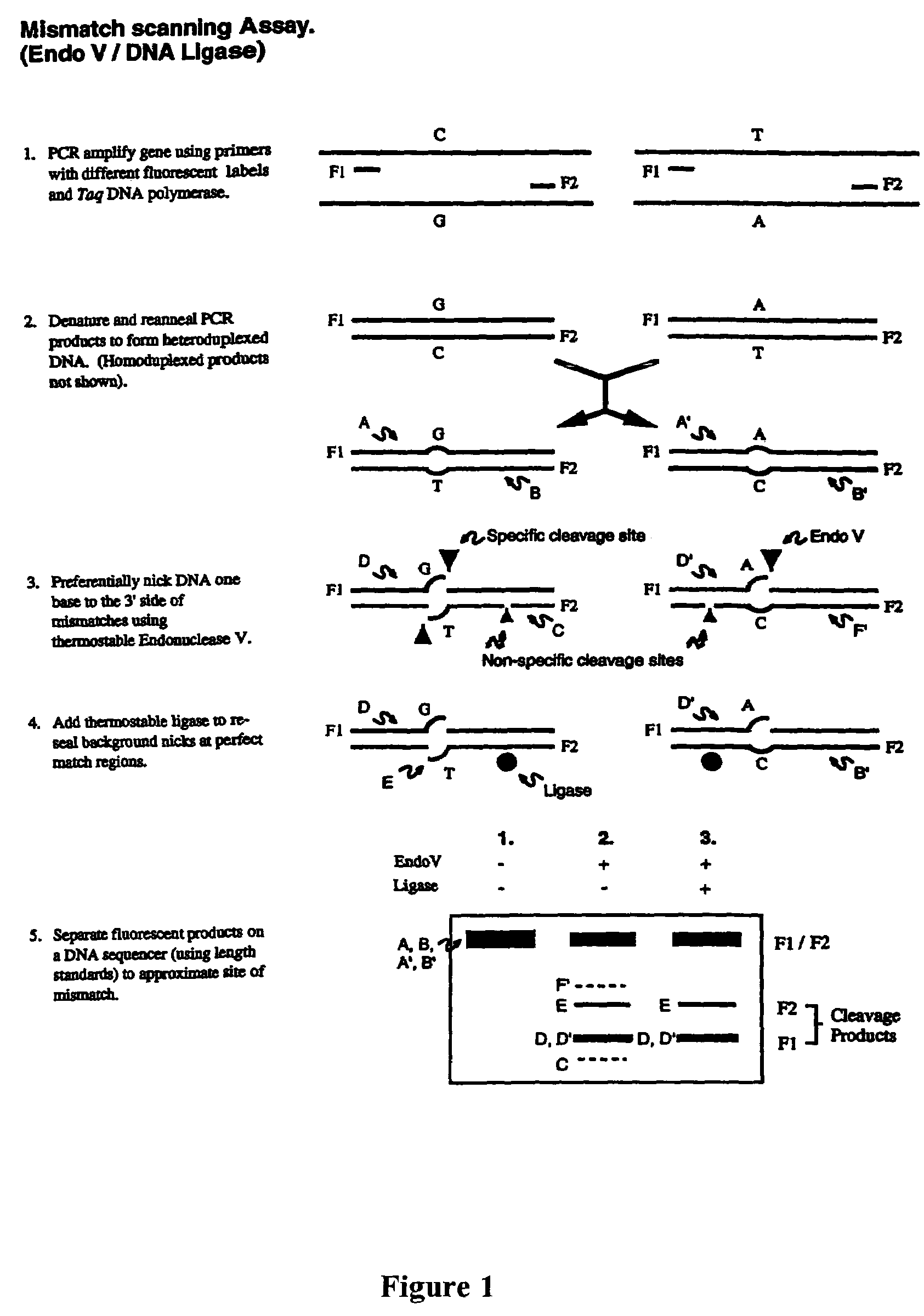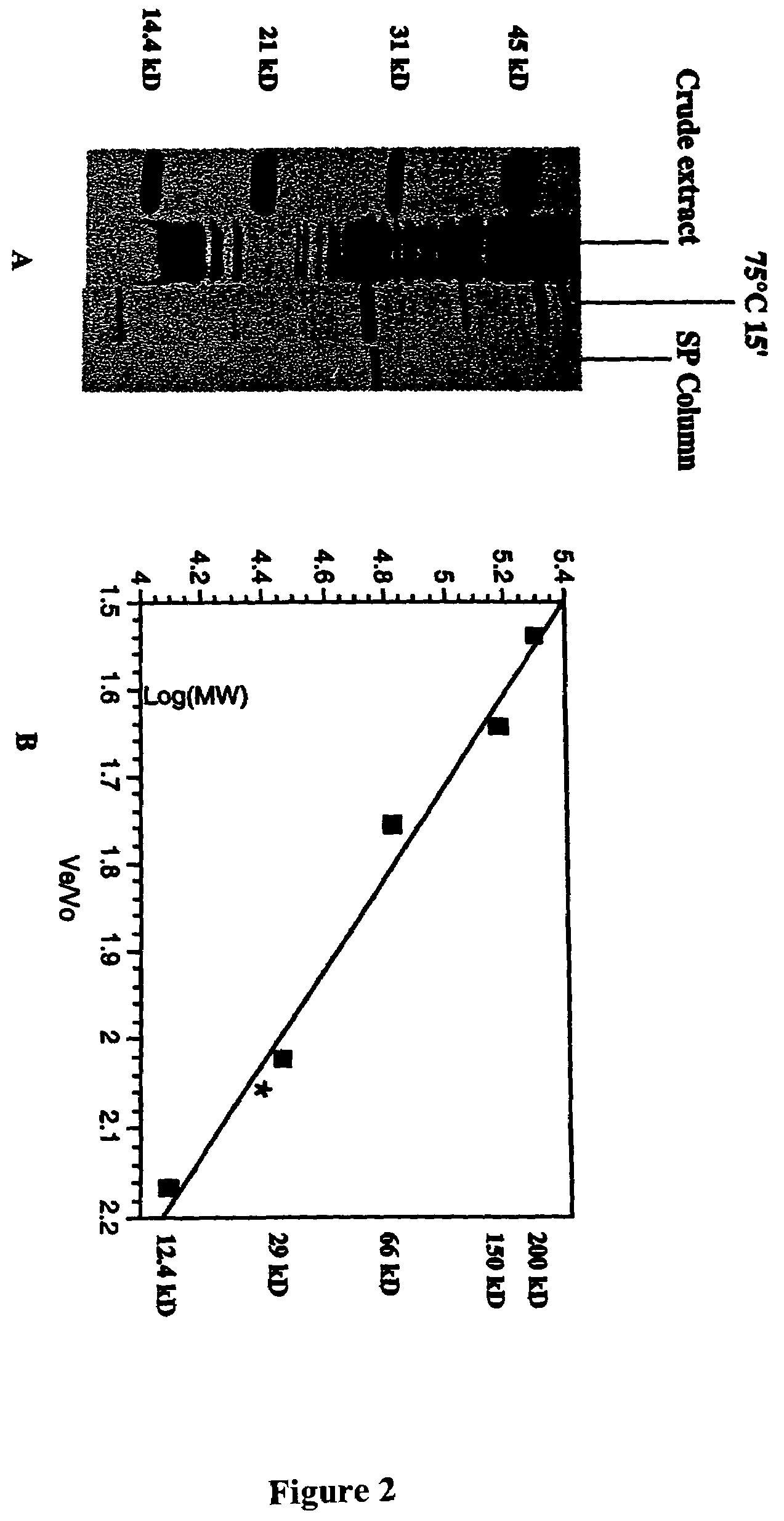Detection of nucleic acid differences using combined endonuclease cleavage and ligation reactions
- Summary
- Abstract
- Description
- Claims
- Application Information
AI Technical Summary
Benefits of technology
Problems solved by technology
Method used
Image
Examples
example 1
Reagents, Media, and Strains
[0081]All routine chemical reagents were purchased from Sigma Chemicals (St. Louis, Mo.) or Fisher Scientific (Fair Lawn, N.J.). deoxynucleotide, BSA, and ATP were purchased from Boehringer-Mannheim (Indianapolis, Ind.). Deoxyoligonucleotides were ordered from Integrated DNA Technologies Inc. (Coralville, Iowa). HiTrap SP columns were purchased from Amersham-Pharmacia Biotech (Piscataway, N.J.).
[0082]Restriction enzymes, T4 DNA ligase and DNA polymerase I (Klenow fragment) were purchased from NewEngland Biolab (Beverly, Mass.). DNA sequencing kits, PCR kits, and GENESCAN-500 (TAMRA) Size Standard were purchased from Applied Biosystems Division of Perkin-Elmer Corporation (Foster City, Calif.). Pfu DNA polymerase, PCR buffer and TaqPlus Precision PCR kit were purchased from Stratagene (La Jolla, Calif.). Protein assay kit was obtained from Bio-Rad (Hercules, Calif.).
[0083]FB medium (one liter) consisted of 25 gram Bacto tryptone, 7.5 gram yeast extract, 6 ...
example 2
Plasmid Construction, Cloning, Expression, and Purification of Thermotoga maritima Endonuclease V
[0086]Through BLAST searches (Altschul, S. F., et al., J. Mol. Biol., 215(3):403–10 (1990), which is hereby incorporated by reference), a putative open reading frame of 225 amino acid has been identified in the Thermotoga maritima genome that shows 34% sequence identity to the E. coli endonuclease V gene. To prove that this, Tma ORF indeed encodes an endonuclease V, it was cloned and overexpressed in E. coli.
[0087]The putative endonuclease V gene (nfi) from Thermotoga maritima was amplified by PCR using forward primer EV.Tma.01A (5′ GGA GGG AAT CAT ATG GAT TAC AGG CAG CTT CAC A 3′ (SEQ. ID. No. 3), the NdeI site is underlined) and reverse primer EV.Tma.02R (5′ GCG CCT GGA TCC ACT AGT TCA GAA AAG GCC TTT TTT GAG CCG T 3′ (SEQ. ID. No. 4), the SpeI and BamHI sites are underlined). The PCR reaction mixture (100 μl) consisted of 50 ng of Thermotoga maritima genomic DNA, 10 μM of forward pri...
example 3
Oligonucleotide Substrates Preparation
[0093]E. coli endonuclease V demonstrates high activity with double-stranded DNA strands containing deoxyinosine-deoxyinosine or deoxyinosine-base mismatch. Yao, M. and Kow, Y. W., J. Biol. Chem., 269(50):31390–96 (1994), which is hereby incorporated by reference. This general characteristic of endo V was used in order to functionally identify the purified Tma endo V enzyme. A double-stranded oligonucleotide containing a base mismatch was designed as a substrate to monitor for cleavage activity by the purified enzyme. FIG. 3A shows a simple assay system using two differentially labeled fluorescent oligonucleotides. The top strand is labeled with 6-FAM and the bottom strand is TET labeled. The mismatch position of the deoxyinosine nucleotide is off-center so that nicked products do not comigrate on a denaturing polyacrylamide gel. The differential double labeling allows the nicking events on both strands to be easily observed and distinguished on...
PUM
| Property | Measurement | Unit |
|---|---|---|
| Temperature | aaaaa | aaaaa |
| Temperature | aaaaa | aaaaa |
| Temperature | aaaaa | aaaaa |
Abstract
Description
Claims
Application Information
 Login to View More
Login to View More - R&D
- Intellectual Property
- Life Sciences
- Materials
- Tech Scout
- Unparalleled Data Quality
- Higher Quality Content
- 60% Fewer Hallucinations
Browse by: Latest US Patents, China's latest patents, Technical Efficacy Thesaurus, Application Domain, Technology Topic, Popular Technical Reports.
© 2025 PatSnap. All rights reserved.Legal|Privacy policy|Modern Slavery Act Transparency Statement|Sitemap|About US| Contact US: help@patsnap.com



